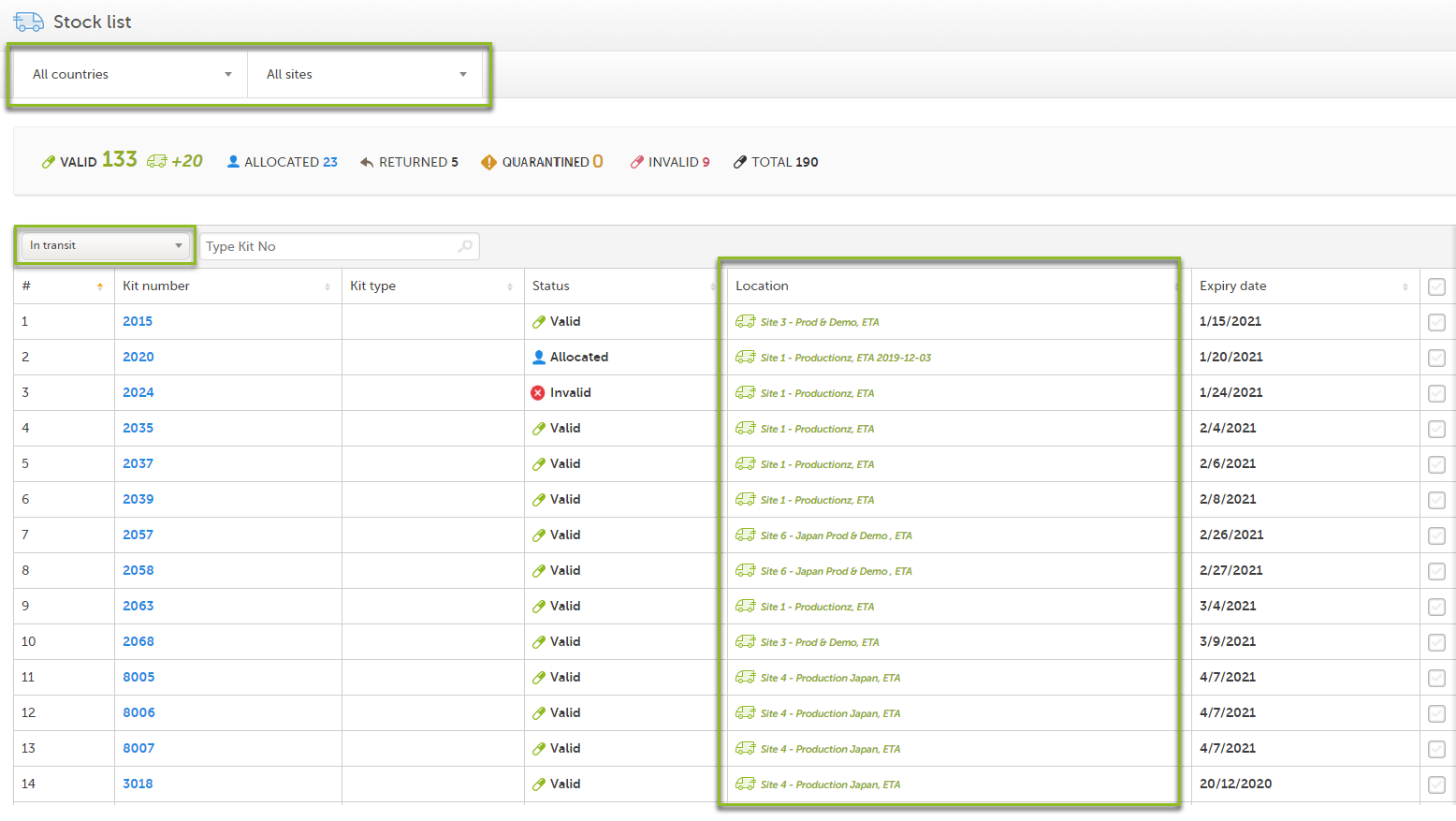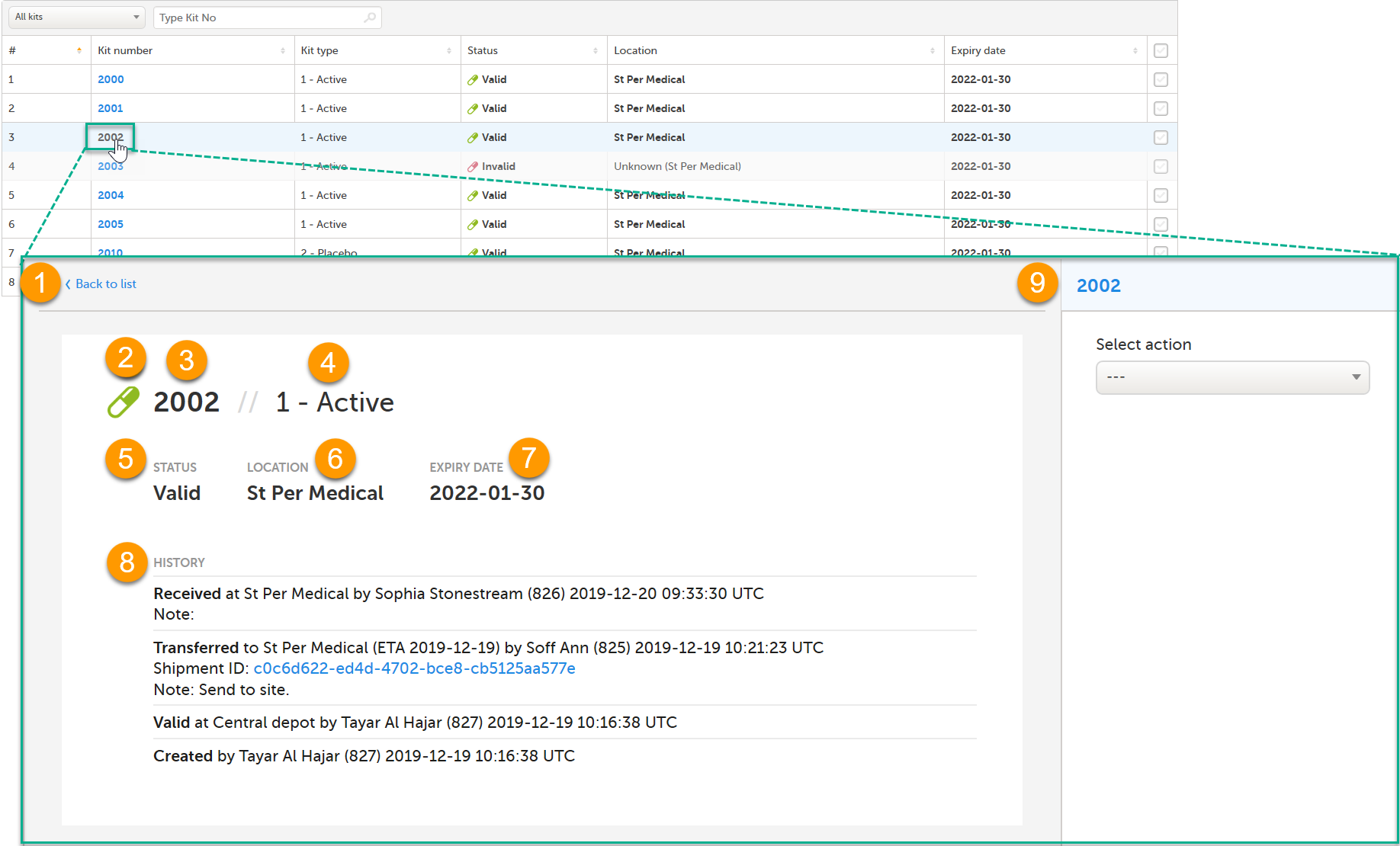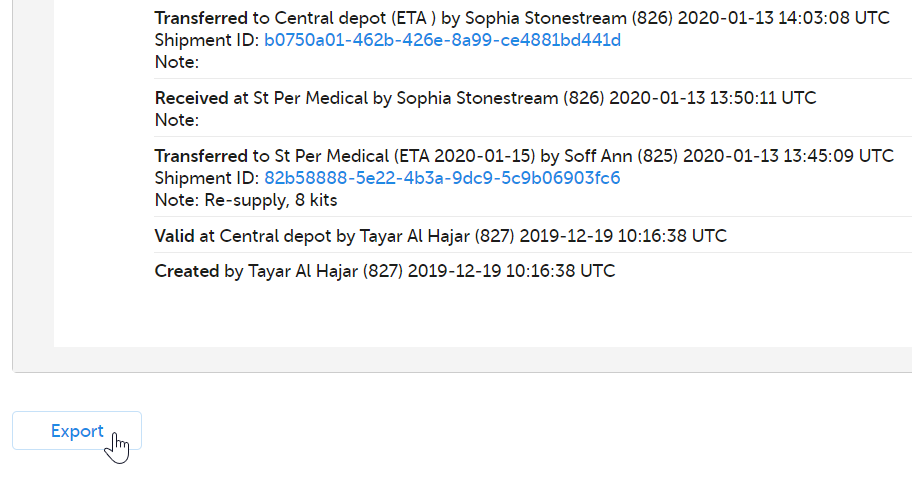Stock list and Kit details view
Introduction
The Stock list page is the landing page for users with site level permissions. Users with study level permissions can also access the Stock list page from the Study supply overview. See Study supply overview for more information.
Overview

In the Stock list page, you find the following functions:
1. Filter the stock list on country. The countries you have access to are listed in the drop-down list.
2. Filter the stock list on site. The sites you have access to are listed in the drop-down list.
3. Metrics pane showing the number of kits based on the selected country and site filters.
The green truck icon with a plus symbol indicates the number of valid kits that are incoming to the filtered locations. If no location filter is set, the total number of kits in transit are shown (All countries/All sites).
4. Filter the stock list on kit status in the drop-down list. You can also select the filter In transit to show kits that are in transit, that is, kits that are shipped from a location but has not yet arrived.
5. Search the stock list for a specific kit number or Shipment ID by typing or scanning the number into the search field. Use comma to search for multiple kits at once, for example 1000,1001,1002.
6. Stock list with columns showing the following information:
- # - list item number
- Kit number - number identifying each kit
- Kit type - only visible for users with permission to view blinded info
- Status - status of the kit (Valid / Allocated / Returned / Quarantined / Invalid / Expired)
- Location - location of the kit: at location or in transit (truck icon)
- Expiry date - date of when the kit expires
- Checkbox - select all kits by checking the top box, select individual kits per row, to make actions in the action pane (7)
The columns of the stock list can be sorted by clicking the small arrows:

7. Action pane, where all the kits are managed. For more information, see Managing kits.
8. Number of list items showing out of the total amount of items, click Previous or Next to browse page.
9. Select the number of kits per page to be shown.
10. Export the stock list, see Export.
Truck icon
The truck icon represents kits that are in transit:
 |
A green truck icon with a destination next to it indicates incoming kits to the filtered location. |
 |
A grey truck with a destination next to it indicates outgoing kits from the filtered location. |
Note! If no location filter is set, kits in transit are shown as incoming to the respective site.

Kit details
When you click on a kit in the Kit number column, the Kit details view opens:

In the Kit details view, you find the following functions:
1. Clickable link - click Back to list to go back to the Stock list page
2. Symbol reflecting the status of the kit. See Kit status for more information.
3. Kit number
4. Kit type - only visible for users with permission to view blinded info
5. Kit status
6. Location
7. Expiry date
8. History showing the audit trail of the kit. All actions performed to the kit are saved with information about when and by whom the action was done. The system automatically registers User action for the following actions: Transfer, Recieve, Cancel, Return. Any notes added to those actions are also registered. If the transfer action was performed to the kit, then the related Shipment ID is listed, as a clickable link. For more information, see Tracking shipments. For the actions Quarantine, Restore, Invalidate, Edit expiry date, the mandatory reason entered by the user is registered.
9. Action pane for managing the kit. For more information, see Managing kits.
Export
At the bottom left of the Stock list page, there is an option to export the stock list into an Excel file. The export is based on the current filter on Country and Site. All kits on all pages are included in the export.
 The export option is also accessible from the Kit details view:
The export option is also accessible from the Kit details view:
 Selecting All kits generates a basic reflection of the stock list with all kits in their current kit status.
Selecting All kits generates a basic reflection of the stock list with all kits in their current kit status.
Selecting All kits incl. history generates a detailed file with all kits and their complete history records.
Selecting Export in the Kit details view generates a file with a history record of the selected kit.
File structure
The Excel export contains the following sheets:

- Info - showing which user made the export at what date and time
- Stock - showing the exported data
Depending on the type of export, the following information is listed in the Stock sheet:
All kits export:
- # - list item
- Kit no - kit number
- Kit type - type of kit treatment. This column is only visible if the user has permission to view blinded information.
- Subject - subject ID. This column is only visible if the user has permission to view the subject ID when allocated.
- Status - kit status at the time of the export
- Current location - kit location at the time of the export
- Shipment ID - ID connected to kits in transit
- Expiry date - date when the kit expires
- Other column - any other kit property that is part of the uploaded kit list is also included in the export
All kits incl. history export and Export from the kit details view:
- # - list item
- Kit no - kit number
- Kit type - type of kit treatment. This column is only visible if the user has permission to view blinded information.
- Subject - subject ID. This column is only visible if the user has permission to view the subject ID when allocated.
- Status - kit status at the time of the export
- Current location - kit location at the time of the export
- Expiry date - date when the kit expires
- Action date and time (UTC) - date and time when the action was performed
- User - name and user ID of the user that performed the action
- Action - action performed
- Action location - location where the action was performed
- Shipment ID - ID connected to the kits if transferred
- ETA - Estimated Time of Arrival entered by the user when performing the transfer
- Reason - data entered by the user performing an action that demanded a reason for the action
- Note - optional note entered by the user performing an action
- Other column - any other kit property that is part of the uploaded kit list is also included in the export
The data on the Stock sheet is organized as follows:
 |
||
| Current kit data at the time of the export | Kit history data | |
